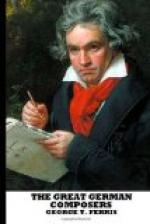RICHARD WAGNER.
I.
It is curious to note how often art-controversy has become edged with a bitterness rivaling even the gall and venom of religious dispute. Scholars have not yet forgotten the fiery war of words which raged between Richard Bentley and his opponents concerning the authenticity of the “Epistles of Phalaris,” nor how literary Germany was divided into two hostile camps by Wolf’s attack on the personality of Homer. It is no less fresh in the minds of critics how that modern Jupiter, Lessing, waged a long and bitter battle with the Titans of the French classical drama, and finally crushed them with the thunderbolt of the “Dramaturgie;” nor what acrimony sharpened the discussion between the rival theorists in music, Gluck and Piccini, at Paris. All of the intensity of these art-campaigns, and many of the conditions of the last, enter into the contest between Richard Wagner and the Italianissimi of the present day.
The exact points at issue were for a long time so befogged by the smoke of the battle that many of the large class who are musically interested, but never had an opportunity to study the question, will find an advantage in a clear and comprehensive sketch of the facts and principles involved. Until recently, there were still many people who thought of Wagner as a youthful and eccentric enthusiast, all afire with misdirected genius, a mere carpet-knight on the sublime battle-field of art, a beginner just sowing his wild-oats in works like “Lohengrin,” “Tristan and Iseult,” or the “Rheingold.” It is a revelation full of suggestive value for these to realize that he is a musical thinker, ripe with sixty years of labor and experience; that he represents the rarest and choicest fruits of modern culture, not only as musician, but as poet and philosopher; that he is one of the few examples in the history of the art where massive scholarship and the power of subtile analysis have been united, in a preeminent degree, with great creative genius. Preliminary to a study of what Wagner and his disciples entitle the “Artwork of the Future,” let us take a swift survey of music as a medium of expression for the beautiful, and some of the forms which it has assumed.
This Ariel of the fine arts sends its messages to the human soul by virtue of a fourfold capacity: Firstly, the imitation of the voices of Nature, such as the winds, the waves, and the cries of animals; secondly, its potential delight as melody, modulation, rhythm, harmony—in other words, its simple worth as a “thing of beauty,” without regard to cause or consequence; thirdly, its force of boundless suggestion; fourthly, that affinity for union with the more definite and exact forms of the imagination (poetry), by which the intellectual context of the latter is raised to a far higher power of grace, beauty, passion, sweetness, without losing individuality




